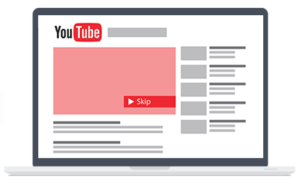Why YouTube?
Since YouTube was created in 2005, the video sharing platform has rapidly become the second most used online search platform, after Google. It also is the third most visited website after Google and Facebook. With billions of users engaging with these sites on a daily basis, they also are the best way for dealers to reach potential car shoppers online. While most companies are familiar with advertising on Google and Facebook, they may be neglecting the power of YouTube in their advertising strategies. If you’re not already incorporating YouTube into your advertising strategy, you should be.
Types of Ads on YouTube
What makes YouTube unique is how it enables the use of both display ads and video ads within a single platform. Acquired by Google in 2006, YouTube shares some of the key advertising features that Google offers, such as display campaigns. Ads began appearing on YouTube in 2007, and since then, YouTube has become a major player in the world of digital marketing.
Display Ads
YouTube Display Ads are created the same way regular Google display campaigns are created. On YouTube, display ads appear to the right of the playing video, above the video suggestions list. Smaller display ads may also appear on the video itself as a semi-transparent overlay covering the lower 20% portion of the video.
Video Ads
YouTube Video Ads have become increasingly popular among advertisers in recent years. There are two types of video ads available on YouTube: (1) TrueView In-Stream Ads and (2) TrueView Discovery Ads.
- TrueView In-Stream Ads appear before, during, or after video content and are skippable after five seconds. To utilize this feature, you would pay on a cost-per-view basis and are only charged when someone clicks on the ad, watches 30 seconds of it, or watches the whole ad.
- TrueView Discovery Ads promote a video in places of discovery, such as next to related videos, as part of a YouTube search result, or on the YouTube mobile homepage. These ads are intended to promote a particular video by directing users to a corresponding YouTube channel page.
Statistics show that viewers who watch just 30 seconds of these ads are 23 times more likely to visit or subscribe to a brand channel or share a brand video. When brands use TrueView, they see views of previous content increase by as much as 500% after posting new content.
Targeting
In addition to playing ads, YouTube also offers different types of targeting so your ads are reaching the key consumers for your brand.
Audience Targeting
YouTube Audience Targeting allows you to select consumers you want to reach by focusing on users that match specific demographics and interests. Targeting narrows down YouTube’s vast pool of users into smaller audience groups that are more likely to engage with your product or brand.
Targeting by demographic allows you to reach an audience of specific ages, genders, parental statuses, or household incomes. For example, if you’re promoting a new SUV geared toward families, targeting parents would help ensure your advertisement is being seen by the potential buyers most likely to be interested in purchasing that vehicle.
Targeting by interests allows you to reach an audience that is interested in a particular topic. This targeting method can be broken down further into five sub-types: (1) In-Market audiences, (2) Affinity audiences, (3) Custom affinity audiences, (4) Life events, and (5) Custom intent.
- In-Market audiences target people who are actively researching a particular product or service. In other words, this method can be applied by targeting people who are in the market for a specific product already.
- Affinity audiences target people who identify themselves with a particular topic based on their hobbies and interests, which is identified from their search behavior.
- Custom affinity audiences customize audiences by targeting specific interests, URLs, places, or apps.
- Targeting particular life events can be used to reach people who are undergoing a significant life change, such as moving, getting married, or graduating.
- Custom intent is a brand-new YouTube targeting feature that allows you to reach users who have searched particular keywords on Google.
In addition, audience targeting can be done by remarketing. Remarketing allows you to reach people who have already engaged with your brand in the past. You also can target individuals that Google determines to be similar to consumers who have visited your website. The lookalikes are selected based on the users’ browser history and content history.
Content Targeting
YouTube Content Targeting allows you to choose where they want to reach the target market by selecting specific keywords. Keywords can target specific content, however, keywords work differently depending on which ad format is being used. For TrueView In-Stream ads, ads show with videos that have tags similar to chosen keywords and where users are interested in those keywords. For TrueView Discovery ads, ads show when a user’s YouTube search matches the particular keywords.
Advertising on YouTube is a strong tool that will help you to reach your target market and drive traffic to your dealership. Now it’s time to take the next step… let L2T help you execute campaigns with your videos! https://www.l2tmedia.com/contact/



